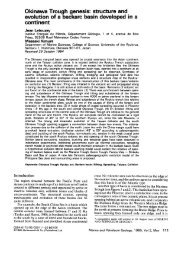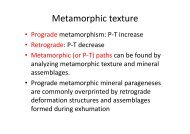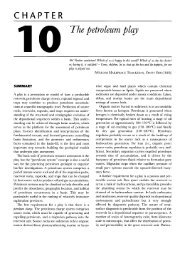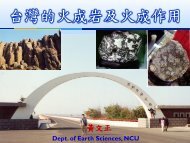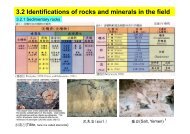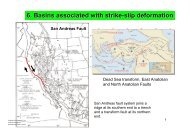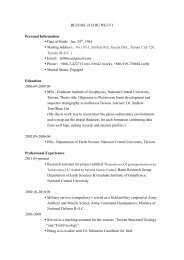Paleosols in clastic sedimentary rocks: their geologic applications
Paleosols in clastic sedimentary rocks: their geologic applications
Paleosols in clastic sedimentary rocks: their geologic applications
- No tags were found...
Create successful ePaper yourself
Turn your PDF publications into a flip-book with our unique Google optimized e-Paper software.
60( )M.J. KrausrEarth-Science ReÕiews 47 1999 41–70temperature Ž MAT .. Ancient climatic conditions canbe <strong>in</strong>terpreted by classify<strong>in</strong>g the paleosols and us<strong>in</strong>gmodern analogs to <strong>in</strong>fer the paleoclimatic regime orby identify<strong>in</strong>g particular pedogenic properties thatmodern studies show to have climatic significance.Stable carbon and oxygen isotopes are also used to<strong>in</strong>terpret ancient climate and some effort has beenmade to use isotopic composition to estimate MATŽ e.g., Mack et al., 1991; Koch et al., 1995 .. F<strong>in</strong>ally,the depth at which calcic horizons orig<strong>in</strong>ally formedhas been used to estimate paleo-precipitation. Thefollow<strong>in</strong>g sections provide overviews of these approachesas well as <strong>their</strong> limitations.5.1. Modern soil analogsThe paleosol literature provides numerous examplesof the classification approach to paleoclimatic<strong>in</strong>terpretation. For example, Mack Ž 1992.used alluvialpaleosols to <strong>in</strong>terpret a climate change across theLower Cretaceous–Upper Cretaceous boundary <strong>in</strong>New Mexico. Older red, calcic paleosols, <strong>in</strong>terpretedas Aridisols, were attributed to semi-arid or aridconditions. These are overla<strong>in</strong> by Inceptisols andAlfisols that have somber colors and lack carbonate,suggest<strong>in</strong>g a subhumid or humid climate. Similarly,Bestland Ž 1997.used paleosols to <strong>in</strong>terpret a climatechange across the Eocene–Oligocene boundary. Theolder paleosols were <strong>in</strong>terpreted as ‘Ultisol-like’ paleosolsthat formed under humid, subtropical conditions,whereas the younger smectitic paleosols werejudged to be ‘Alfisol-like’ and <strong>in</strong>dicative of humid,temperate conditions.In a more unify<strong>in</strong>g approach to paleoclimatic<strong>in</strong>terpretation, Mack and James Ž 1994.generated apaleosol analog to the Soil Map of the World Že.g.,FAO, 1974 ., which l<strong>in</strong>ks modern soils to particularclimatic zones. Us<strong>in</strong>g the Mack et al. Ž 1993.paleosolclassification Ž Table 1 ., they suggested that highlyweathered paleosols, such as Oxisols and Argillisols,should be characteristic of wet equatorial paleoclimates<strong>in</strong> which MAP and MAT are high and havelittle seasonal variation. Argillisols, Spodosols, andGleysols are more apt to form <strong>in</strong> humid ŽMAP)1000mm.midlatitude climates, whereas Calcisols are <strong>in</strong>dicativeof a dry Ž MAP-1000 mm.subtropicalpaleoclimatic zone. One caveat to this global approachis that it is not appropriate for paleosols thatformed prior to the advent of vascular plants.The second approach to climate reconstruction—focus<strong>in</strong>g on a particular soil property or group ofproperties—is based on Quaternary soil studies,which have shown that particular features, <strong>in</strong>clud<strong>in</strong>gclay and carbonate accumulations and the depth ofsoil oxidation can be quantitatively related to soilform<strong>in</strong>gfactors, <strong>in</strong>clud<strong>in</strong>g climate Že.g., Bockheim,1980; Harden and Taylor, 1983; Birkeland, 1984 ..Molecular weather<strong>in</strong>g ratios Že.g., silicarsesquioxidesor basesralum<strong>in</strong>a.provide a good illustration.In some cases, the ratios <strong>in</strong>dicate <strong>in</strong>tense leach<strong>in</strong>g ofbase cations and the loss of silica, which are characteristicsof modern soils that formed <strong>in</strong> humid, tropicalclimates Že.g., Arndorff, 1993; Retallack andGerman-He<strong>in</strong>s, 1994; Gill and Yemane, 1996 .. Claym<strong>in</strong>eralogy has also been used to detect and <strong>in</strong>terpreta climatic change. Robert and Kennett Ž 1994 ., forexample, found that clay m<strong>in</strong>erals on the Antarcticcont<strong>in</strong>ent showed a dramatic <strong>in</strong>crease <strong>in</strong> smectiteŽ and correspond<strong>in</strong>g decrease <strong>in</strong> illite.dur<strong>in</strong>g thelatest Paleocene. The clay change corresponds to awell-documented isotopic shift that marks the latestPaleocene thermal maximum Že.g., Zachos et al.,1993 .. Robert and Kennett concluded that the <strong>in</strong>crease<strong>in</strong> smectite was the result of <strong>in</strong>creased chemicalweather<strong>in</strong>g as a result of warmer temperaturesand greater ra<strong>in</strong>fall at that time.In some cases, the paleosols are parts of cyclothems<strong>in</strong> which alternations of particular k<strong>in</strong>ds ofpaleosols are l<strong>in</strong>ked to climatic cycles. Good examplesare provided by the wetrdry cycles l<strong>in</strong>ked topedogenically-unmodified sediment and paleosols <strong>in</strong>loess and loessite. In some, the cyclic climaticchanges are l<strong>in</strong>ked to either sea-level changes ortectonic activity. For example, work<strong>in</strong>g <strong>in</strong> LowerPermian cyclothems of the U.S. mid-cont<strong>in</strong>ent, Milleret al. Ž 1996.described cyclic changes from verticpaleosols to Alfisols with calcic horizons and attributedthese to fluctuations between semi-aridrsubhumidconditions and humid monsoonal conditions.In a subsequent study Ž McCahon and Miller, 1997 .,these paleosolrclimate cycles were l<strong>in</strong>ked to glaciallycontrolled sea-level changes. The change to <strong>in</strong>creasedprecipitation followed by a rapid changeback to arid conditions was attributed to gradualregression caused by glacial activity followed by a



